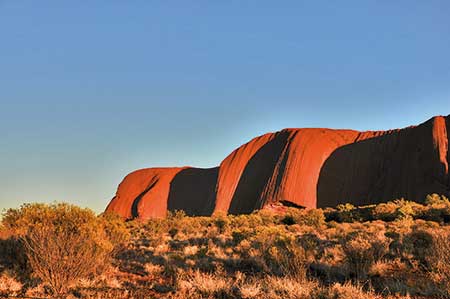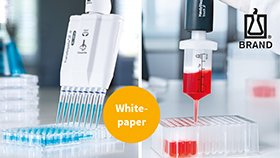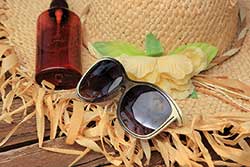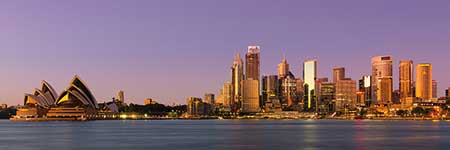Australia - G’Day Oz! Prospering Biomed Research Down Under
Career strategies for young European scientists
by Ralf Schreck, Labtimes 01/2013
Crocodile wrestling, kangaroo boxing, shrimps on the barbie and well-toned surf-lifesavers: too many stereotypes impede an unbiased view of Australia. Besides being a prime destination for students and tourists, Australia has also become attractive for the scientist from abroad.
The Aborigines’ ancestors entered Australia via the Malay Archipelago about 50,000 years ago. Of major historical importance for Australia were the establishment of penal colonies in Australia in the late 18th century by the Brits and the immigration of hundreds and thousands of prospectors from all over the world, in the course of multiple gold rushes in the middle of the 19th century. The six independent British colonies became a federated entity as the Commonwealth of Australia in 1901.
A large-scale immigration programme after World War II further raised the population by more than 6.5 million. Today, one in four of the 23 million Australians was born overseas. Moreover, with about 425,000 international students, a seven percent share of the world’s foreign students, Australia has become the third most appealing destination after the US and the UK. Melbourne and Sydney are among the first six in the QS Best Student Cities world assessment. Up to seven Australian universities are represented in the top 100 of major university rankings and provide ample research opportunities.
Australia also harbours outstanding research infrastructures such as two supercomputers among the world’s top 40 and one of the fastest telescopes, the A$150 million Australian Square Kilometre Array Pathfinder. Here, Lab Times tells you, how Australia is upgrading its research landscape to cope with future challenges.
Oz at a glance
The Commonwealth of Australia with its capital Canberra is the sixth-largest country by area and the 52nd-largest country by population. With less than three people per square kilometre it is one of the most sparsely populated nations in the world.
Australia’s major cities are Sydney with 4.6, Melbourne with 4.2 and Brisbane with 2.1 million citizens. About three quarters of Australians live in metropolitan and coastal areas. Australia is divided into six states and two major mainland territories. It is a federal parliamentary democracy and constitutional monarchy. Australia became independent in 1986 but a referendum on becoming a republic with a president was turned down in 1999. Thus, Queen Elizabeth II is still the constitutional Head of State and is represented by a governor-general at the national level and governors at the state level. Julia Gillard is the current Prime Minister and Head of Government, in office since June 2010. The current value of the Australian Dollar (A$) equals roughly that of the US Dollar ($).
Australia’s economy is the 12th largest in the world and is dominated by the service sector. But economic growth depends to a large extent on mining and agriculture. More than 60% of its exports are earmarked for East Asia. Main trading partners are China, the US and Japan.
Overall, Australia is quite well-positioned with respect to its economic competitiveness. It was rated second-best after Norway in the United Nations Human Development Index, which considers education, income and life expectancy. In more elaborate rankings, Australia is also doing reasonably well: it is placed 15th in the 2012 IMD Yearbook of the World Competitiveness Centre and 20th in the most recent Global Competitiveness Report by the World Economic Forum. One of Australia’s most striking advantages is its financial sector with one of the most stable and resilient banking systems worldwide. Top scores in rankings are also received repeatedly for its tertiary education system, whereas strict labour regulations and excessive bureaucracy lead to devaluation.
From the Didgeridoo to Wi-Fi
Many countries have hundreds of years at their disposal to set up a fully-fledged university and research system. On the contrary, Australia had to cut short on evolution and has developed into a modern, innovation-driven society within the last 100 to 150 years. The aerophone Didgeridoo and the spear-thrower Woomera are inventions dating far back. About newer inventions it is often said that they have their origins either in the island-like nature of Australia, which allows access only via air or water, or in its richness in natural resources, which creates a high demand of innovations for mining and agriculture. Examples are the black box flight recorder, the inflatable aircraft escape slide, the wave-piercing catamaran, the surf ski, the grain stripper, the Buffalo fly trap, the Wolseley mechanical sheep shear or the froth flotation process for ore separation. In medical technology cochlear implants, multi-focal contact lenses, spray-on skin for burn victims or the anti-flu drug Relenza have Australian origins.
In the high-tech sector Australia is often forced to fight in court to get its deserved recognition but also royalties. Widely known is the struggle surrounding the wireless LAN (WLAN) technology, which was patented in the 1990s by the Australian John O’Sullivan and his group. This technology has brought wireless network connectivity to billions of devices worldwide. In 2009 and 2012 O’Sullivan’s employer CSIRO, the Australian Government body for research, reached highly disputed settlements in two major lawsuits in the US for patent infringements, which brought at least A$430 million into CSIRO’s coffers.
Bright spots in pharma and biotech biz
With respect to its innovation performance, Australia is nowadays seen as a fast-follower country. This means that it is not a business leader in terms of new-to-the-world innovations, in general. But certain sectors such as pharma and biotech are able to score. They shine with a well-established medical device industry, strengths in nanobiotech and international recognition for stem cell research.
The medicines industry is the number one in high-tech exports and clearly ahead of the auto or wine industry. Australian biotech represents the world’s largest biotech sector as a proportion of the gross domestic product, as highlighted in the report “Beyond Borders” by Ernst & Young. According to AusBiotech (www.ausbiotech.org), Australia is home to more than 470 biotech companies with a focus on therapeutics (50%), agricultural biotech (16%) and diagnostics (13%). Australia offers upscale clinical trials but has the reputation for providing high-quality data, a fast regulatory framework and attractive tax incentives. This has also been recognised abroad and the A$1 bn clinical market is nowadays driven by a direct foreign investment of more than 45%.
CSL, the Commonwealth Serum Laboratories, is Australia’s biotech dinosaur with a market value of A$20 bn. It started as a small governmental vaccine-producing unit in 1916, was privatised in 1994 and is now a global market leader with a focus on biotherapies, vaccines, antivenoms and blood plasma derivatives. CSL earns a 6.5 percent royalty on global sales of the blockbuster vaccine Gardasil. It is used to prevent infections by certain types of human papillomavirus, which are associated with cervical and additional cancers. The Australian immunologist Ian Fraser at the University of Queensland made major contributions to the development of Gardasil and engaged CSL as sponsor for clinical trials. As the first country in the world, Australia decided last year to give free vaccine shots not only to girls but also to boys.
Another world leader is Cochlear Limited with headquarters in Sydney. The company has been providing solutions for hearing loss including cochlear and bone conduction implants for 30 years. Part of its success is due to the highly diversified R&D programme, which devoured A$120 million or a third of Cochlear’s revenues last year.
Other highlights in 2012 included a $345 million deal between Adelaide-based Bionomics and Ironwood Pharmaceuticals from the US to develop a new anxiety drug candidate, the EU approval of Pharmaxis’ Bronchitol, a new Cystic Fibrosis drug, and the continuous growth and strong product pipeline of Melbourne-based Mesoblast Limited, one of the forerunners in adult mesenchymal precursor cell therapy.
Trumps in biomedical research
But what about Australia’s standing in the scientific community and its scientific output? Thirteen Nobel Prizes are claimed by Australia. Not that many! But enough to be among the top ten countries by Nobel laureates per capita of nations with more than 20 million citizens. Most of the awards have been made in the category “Physiology or Medicine”.
Howard Florey enabled large-scale production of penicillin in the late 1930s, Macfarlane Burnet developed the concept of acquired immune tolerance and John Eccles contributed significant insights into synaptic transmission. More recent laureates include Peter C. Doherty for discovering the involvement of the MHC complex in T cell recognition, J. Robin Warren and Barry Marshall for associating Helicobacter pylori and gastric disorders or Australian-born Elizabeth Blackburn for work on telomere function.
With respect to its publication record, Australia also keeps in touch with the leading nations worldwide. According to the SCImago Country and Journal Rank, it is eleventh with respect to citable documents and twelfth concerning citations per document in the period 1996-2011. As figured out by Thomson Reuters, Australia’s share of the world’s top 1% of highly-cited publications in natural sciences and engineering was 5.28% in 2011, which secured the eighth place among OECD countries.
Moreover, the SCImago Ranking of Worldwide Research Institutions 2012 is listing four Australian entries among the top 100: the Universities of Sydney, Melbourne, Queensland and New South Wales. In the Excellence Rate Report 2011 of the same provider, in which institutions are listed according to their contribution to the upper tenth of most-cited papers, Australia’s biomedical research sticks out. The Walter and Eliza Hall Institute of Medical Research in Melbourne (12th) and the Garvan Institute of Medical Research in Sydney (13th) were close to renowned institutions such as Rockefeller University or Wellcome Trust Sanger Institute. The Florey Neuroscience Institutes and the Peter MacCallum Cancer Centre, both in Melbourne, as well as the Queensland Institute of Medical Research in Brisbane also made it to the top 100 roster of leading research institutions.
Fragmentation and commercialisation
The Department of Innovation, Industry, Science and Research and Tertiary Education (DIISRTE) is the super department in research policy and funding in Australia. Three-quarters of public research funds are at its disposal. DIISRTE is headed by Senator the Hon Chris Evans and operates 17 divisions and twelve portfolio agencies, including the Australian Research Council (ARC) and Australia’s national science agency CSIRO. Other departments take care of policies and funds in their area such as the Department of Health and Ageing, which oversees the National Health and Medical Research Council (NHMRC).
Individual states and territories also fund research primarily within the regional context but have only moderate impact with a share below 5% of national R&D expenses. At the operational level, there are several research coordination bodies including the novel Australian Research Committee (ARCom), which is chaired by Australia’s Chief Scientist Ian Chubb, who is also representing Australia’s science internationally. ARCom was initiated after a review of publicly funded research in 2011, which did not find any shortcomings but stated that a better dialogue and coordination of research effort and investment would add extra value. ARCom also developed the current National Research Investment Plan, which was released in November 2012, and which has set out to take Australia’s system of research and innovation into the world’s top ten.
Research, reports, resources
Research policy in Australia is based on periodic monitoring, reporting and the development of multi-annual strategies, which set funding priorities and targets. One example of an annual report is the Australian Innovation System Report. Another good read is the 356-page report “Excellence in Research for Australia (ERA)”, which provides many insights into research performed at higher education institutions from 2005 to 2010 and also formed the basis for the first performance-based allocation of university funds. ERA is based on a combination of scientometrics and expert review, and is a valuable resource for those interested in past accomplishments and trends of particular Australian universities or specific research fields.
The present Government strategy termed “Powering Ideas: An Innovation Agenda for the 21st Century” was released in 2009 and gives a ten-year outlook. Main points raised were to increase the overall number of research groups and universities performing at world-class level, to strengthen internationalisation and to foster collaborations between different public and private research performers by adjusting funding streams along national priorities.
As other countries too, the Australian Government has come under pressure to justify new investments into R&D by environmental, societal or economic benefits. The climate change will be addressed by the A$1.2 bn Clean Energy Initiative and a Renewable Energy Agency, whereas economic benefits to research are abetted by new Cooperative Research Centres, the A$1.1 bn Super Science Initiative (2009-13) or the A$236 million programme Industrial Transformation Research Programme, which has just started.
Committed to investment in science
Australia’s Government put a temporary freeze on all grants in the run-up to its mid-year economic and fiscal outlook late last year. Missing tax revenues and falling commodity prices prompted a A$16 bn austerity package. Scientists were concerned about being targeted but in the end, major funding programmes were left untouched. However, universities will suffer by cuts amounting to more than A$0.5 bn over the next four years in frame of the Sustainable Research Excellence initiative.
According to the Australian Bureau of Statistics, Australia spent close to A$31 bn on research and development (R&D) in the last budget year, which is 2.2% of its gross domestic product. The business sector accounted for roughly 58% and the Government for about a third. The official science, research and innovation budget tables indicate that the Government will spend roughly A$8.9 bn on R&D activities this year. A breakdown by performance reveals that universities are the major recipients (32%), followed by the business sector (25%) and the Government research sector (20%). Main expenses are in the Higher Education sector the performance-based block funding of universities (A$1.9 bn) and the funds of the Australian Research Council (A$0.88 bn), in the business sector R&D tax measures (A$1.83 bn) and in the Government sector funding of the national science agency CSIRO (A$0.74 bn). In the multi-sector category, which is open to all three sectors, costs for the National Health and Medical Research Council, NHMRC, (A$0.95 bn) stand out. The Australian Research Council as the main funding source of research at universities and the Commonwealth Scientific and Industrial Research Organisation (CSIRO) as largest governmental research agency will be covered in more detail below.
Motza from the ARC
The Australian Research Council (ARC) is the main funding agency in support of research at universities. It also acts as scientific advisor for the Government and is in charge of evaluating Australia’s research system. The ARC’s mission is to “advance Australian research and innovation globally to the benefit of the community”. The funding of competitive research, the promotion of research partnerships between the public and private sector and internationalisation are major activities. All fields from basic to applied research are supported. About one-tenth of funding goes into health and well-being but clinical research and dentistry are excluded and covered by the NHMRC. ARC’s current budget is estimated to be in the range of A$0.88 bn or close to ten percent of governmental R&D expenses.
The ARC was established in 2001 as an independent body under the auspices of DIISRTE. Nowadays, the ARC has about 125 staff members and is headed by Aidan Byrne as Chief Executive Officer, who shows his enthusiasm, “The ARC is a very lean funding body with administration costs amounting to just 1.3 % of the whole ARC funding volume. This is very low compared to other agencies in Australia and worldwide.”
Major funding programmes have just one application deadline per year. Last year the ARC received 7,700 applications, out of which three-quarters were dismissed. According to Aidan Byrne, 60% of funded proposals include international activities with the US, the UK, Germany, France and China as most favoured collaborating countries. Proposals are subjected to peer review by the ARC College, which consists of elected members from different sectors. Funding applications are allocated to two appropriate College members, who in turn select two experts for in-depth review. Proposals are ranked and final funding approvals are made at one of two annual meetings.
The National Competitive Grants Programme (NCGP) of the ARC has two main pillars: DISCOVERY is funding primarily bottom-up research projects by individuals or teams of scientists, whereas LINKAGE is encouraging collaborations between researchers, industry, institutions and end-users but also allows the financing of large-scale infrastructure, equipment and facilities. ARC Centres of Excellence provide hot spots for high-quality research and are meant to foster collaborations between the public and private sector in Australia but also overseas. They are funded for up to seven years with an annual budget of up to A$4 million and extra funds by the partners.
Additional co-funded Centres include the Australian Stem Cell Centre and the Australian Centre for Plant Functional Genomics. Special Research Initiatives (SRI) target emerging research areas. For example, Bionic Vision Science and Technology received support with a A$50 million package for a four-year period starting in 2009, whereas Stem Cell Science was further promoted by A$21 million for a seven-year period starting in 2011. Australia also became an associate member of the EMBL in 2008 and co-finances a research group at the EMBL Heidelberg within the SRI scheme.
Pick your fellowship
The Discovery scheme encompasses fellowships, grants and awards for different career stages, which are also open to incoming scientists from abroad. The standard research grant is the so-called Discovery Project. More than 900 new projects per annual call with an average success rate of 22% have been approved in the past. Discovery projects earn between A$30,000 and A$500,000 a year for up to three years. Of importance is the International Collaboration Award (ICA) that may be applied for, if the applicant wants to add international activities to his project. The ICA is A$20,000 on top of the research grant for each of up to two international collaborators, who may use the money for up to a six-month research stay in Australia.
The Discovery Early Career Researcher Awards (DECRA) enable research-only or research and teaching appointments for early career scientists. Host organisations are universities but also governmental research agencies such as CSIRO. International candidates are eligible as long as they apply via an Australian institution and intend to work predominantly in Australia. Candidates may apply up to five years after the completion of their doctorate. Research has to be performed along the National Research Priorities. Proposals are evaluated for quality (50%), applicant (30%), research environment (10%) and feasibility and benefit (10%).
Two hundred three-year awards of up to A$125,000 per year and call are assured and may be used for equipment, a PhD student or travel costs but do not cover bench fees, suntan lotion, relocation expenses or general infrastructure. About 1,300 applications were sent in last time with a success rate of 16%. Eight awardees were returning Australians, whereas 58 were foreign nationals. The next deadline for submission of proposals is end of March 2013.
Mid-career scientists may benefit from Future Fellowships. During the five-year duration of the programme (2009-13), 1,000 four-year fellowships worth between A$190,000 and A$250,000 a year, which is dependent on research experience, will be made available. Funded is research in areas of critical national importance, which are published in the annual calls. In 2011, 600 applications were made and 200 proposals received funding. The last call will close on Feb 20, 2013.
Australian Laureate Fellowships target top-class scientists with the aim to attract or retain them. Proposals have to be submitted by Australian or international candidates, who must become a full-time employee of their host institution, which is either a university or public research institution. Fellows benefit on average from a A$2.75 million package for a five-year period, which allows the setting-up of an effective group and the focus on science without worrying too much about funding. Included is a salary supplement of up to A$146,138 and additional funds for up to two postdocs and up to two postgraduates may be added on top. The host institution may receive up to A$300,000 a year to cover project-related costs. In the last round, 17 Fellows prevailed with a success rate of about 16%. One out of six applications by ex-pats and two out of eleven proposals by foreign nationals were approved. The next call for proposals is expected for late 2013.
CSIRO
There are several Governmental research performing bodies of varying sizes, which receive in total A$1.8 bn per year to cover intramural R&D activities. Examples are the Defense Science and Technology Organisation (DSTO), the Australian Institute of Marine Science (AIMS), or the Commonwealth Scientific and Industrial Research Organisation (CSIRO).
The largest national agency is CSIRO with 6,600 employees at 57 locations. Its predecessor, the Advisory Council for Scientific and Industrial Research (CSIR), was established in 1926 with a research focus on agriculture. CSIR became CSIRO in the middle of the 20th century and its research activities were expanded to other areas according to national priorities, societal challenges or industrial demand. Nowadays, research is performed in several divisions organised in four groups: Food, Health and Life Sciences Industries; Information Sciences; Environment; and Manufacturing, Materials and Minerals. CSIRO operates three National Research Facilities such as the Australian Animal Health Laboratory at Geelong and more than 30 additional research facilities such as the Riverside Life Sciences Centre at Sydney. CSIRO also takes care of national collections such as the Australian National Fish or Insect Collections. The use of collections and facilities including the Collaborative Crystallisation Centre or the Biomolecular Interaction Facility in Parkville and the Recombinant Protein Production and Purification Facility in Clayton are available for external users via partnership agreements or on a fee-for-service basis.
About A$737 million or half of CSIRO’s annual budget is provided by the Government. Additional significant income is derived from sales of goods and services but also royalties or settlement payments as for the WLAN patent. In order to take a more focused approach on scientific issues and challenges of national importance, the Flagship Collaboration Fund (FCF) was established by the Australian Government in 2005 and the National Research Flagship Programme was launched. Flagships encourage national and international large-scale and mid- to long-term collaborations along national priorities between CSIRO and other research agencies, institutions and the business sector. Currently, there are eleven flagships in operation including Biosecurity, Food Futures, Preventive Health or Sustainable Agriculture. The Flagship Collaboration Fund offers competitive funding for temporary research clusters but also for individuals in the form of research projects and postgraduate or visiting fellowships.
Boarding the flagships
How can researchers from abroad benefit from CSIRO? Flagship Visiting Fellowships are available for established researchers for up to six months. Up to A$100,000 are provided but matching funds by your home institution or another funding organisation are expected. Prior to your application, the flagship of your choice should be contacted. PhD students may apply for Flagship Postgraduate Scholarships and, upon success, are jointly supervised by university and CSIRO researchers. About 300 PhD students in total are sponsored each year. If the student already has a fellowship from a different source, he or she may receive an annual top-up of A$7,000 for three years. PhD students without a fellowship receive a full fellowship of A$31,653 per annum. Moreover, travel and operating costs and up to A$6,000 for an international conference and associated overseas laboratory visits are covered.
International students may apply but have to give proof of admission to an Australian university and of coverage of living costs or tuition fees by other sources. There is one application round per year in priority research areas relevant to a flagship, which may change over time. In addition, CSIRO offers about 20 three-year postdoc fellowships, which are posted in May and October at its Positions Vacant website.
Australian Higher Education
The first Australian universities were founded in Sydney (1851) and Melbourne (1853). The university sector of Australia has grown rapidly over recent years and reforms along the ten-year strategy Transforming Australia’s Higher Education System, released in 2009, are in progress. The Australian higher education system encompasses 39 universities, out of which 37 are public. The eight high-performing universities with respect to research funds and scientific output are organised in the Group of Eight (www.go8.edu.au).
Each of these universities has a total annual research income above A$125 million. More than 300,000 students including 22,000 PhD students are enrolled with the Go8 and the share of international students is about 25%. The following universities are members and their placement in the latest QS World University Ranking is as indicated: the Australian National University (24), the University of Melbourne (36), the University of Sydney (39), the University of Queensland (46), the University of New South Wales (52), Monash University (61), the University of Western Australia (79) and the University of Adelaide (102).
The Group of Eight has significant influence on policies in the higher education and research sector, and it offers a couple of own programmes and fellowships, which are also of interest for the international talent.
For example, there is the Australia-China Young Researchers Exchange Programme, the Go8 Germany Joint Research Co-operation Scheme, which supports the bi-directional exchange of PhD students or scientists in joint projects, or the Go8 European Fellowships, which enable research stays of up to six months at Go8 universities and are earmarked for early career scientists from specific East European countries. The Go8 also operates Australia’s Knowledge Gateway (www.akg.edu.au), which is a search engine for people, projects or publications and may assist you in finding your future host at an Australian institution. The Go8 also provides plenty of support and details for internationals at all levels, who are interested in becoming part of the scientific community in Australia.
Even more fellowships
The Australian Government is investing over A$250 million per year for incoming and outgoing scholarships, which support around 4,500 international students, researchers and professionals from over 160 countries. Australia Awards were established in 2009 and bring together scholarship programmes run by DIISRTE and the Australian Agency for International Development (AusAID) under a single brand.
Fellowships come in two flavours: development scholarships are in support of people from developing countries, whereas Endeavour Awards is a merit-based programme targeting only the best from the Asia-Pacific, the Middle East, Europe or the Americas. About two-thirds of incoming recipients were from the Asia region in 2011, with incoming scholars from Indonesia, Vietnam and Papua New Guinea as major recipients. Offered are short-term and long-term awards.
Endeavour Postgraduate Awards enable, for example, studies towards an Australian Master or PhD degree up to a maximum of fours years and A$228,500 in total. The Prime Minister’s Australia Asia Incoming Postgraduate Award enables postgraduate research to obtain an Australian PhD in up to four years and one year of optional internship with a total of A$263,500. Endeavour Research Fellowships may be also applied for by postdocs and support a research stay between four and six months with up to A$23,500. For Endeavour Awards there is one deadline per year around April. Applicants wishing to study or work towards a degree must give proof that they have gained admission into an Australian university, while applicants for a research fellowship are nominated by the host university.
There are also a number of charitable foundations in the medical and health sector offering a limited number of research fellowships. Examples include the National Breast Cancer Foundation or the National Heart Foundation of Australia. Also not covered in more detail due to space limitations are the fellowships of the National Health and Medical Research Council (NHMRC).
In the last year, about 450 fellowships started and were supported with about A$150 million. They are available for different levels of research experience for postgraduates, postdocs and established researchers involved in biomedical or clinical research.
Outlook
At this point in time, the overall research system of Australia is not on equal terms in all aspects with the world’s leading nations but ongoing reforms address the shortcomings. Australia has many internationally acknowledged research institutions and universities, which offer plenty of opportunities to earn a doctoral title or to spend a couple of years as a postdoc. The Government has increased the total number of fellowships for international PhD students and scientists over the last years.
As outlined in the Asian Century White Paper, a major focus of Australia’s Government will be on its full integration within the regional context in order to benefit from the rise of Asia. Therefore, more efforts including scientific cooperation will be directed towards Asia. But Australia is also trying to deepen its relations with Europe and the project CAESIE, Connecting Australian-European Science and Innovation Excellence, which recently started and will promote the participation of Australia in European Framework Programmes. Thus, Australia is open to international exposure from all directions and will welcome the European scientists, who pick Down Under as first choice for their next career step.
Internet Resources
Last Changed: 07.02.2013










